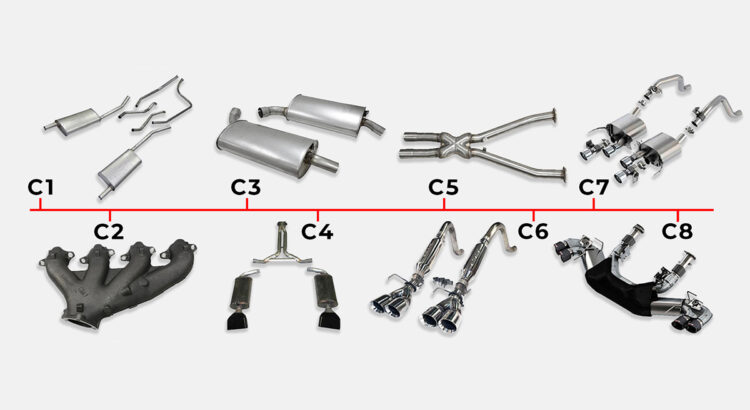It seems like since Americans began to work and fix cars on their own, there always has been the inclination to try to extract more horsepower from whatever power plant that their car may have. This phenomenon is probably more prevalent in Corvettes than almost any other make. It seems that the first option for many early enthusiasts to feed the need for speed was the addition of a new set of tube headers and a freer flowing exhaust system. Almost all early Corvette exhaust systems until the 1981-82 model years used the standard cast iron exhaust manifolds and small diameter pipes leading to restricted-flow mufflers. It was much easier in the early days to change to the exhaust system of your choice. That doesn’t ring true today though, with so many strict EPA emissions standards in certain parts of the world.
Corvette Exhaust Upgrades
Many Corvettes, when purchased new back in the day, did not make it home before the anti-pollution apparatus was pitched and the cast iron manifolds were junked for a new set of headers. Although late model Corvettes now use stainless steel headers and systems from the factory, the designs still must meet stringent EPA guidelines and are definitely not suited to increased horsepower gains when engine modifications are done. The addition of headers to an otherwise stock Corvette can yield anywhere from a 15% to 30% horsepower gain at the rear wheels, if those parts can be added and still within EPA guidelines of your locale.
This is really a great return on your investment, given the fact that most headers are usually quite reasonable in price and install easily in an afternoon. Many of the factory replacement headers today will fit with minimum modifications, that usually being the fabricating of new head pipes that attach to the headers themselves. Some header manufacturers also supply these head pipes as an option. Many of the headers that are designed to fit late model applications also have anti-pollution fixtures that will accept the original factory smog system. Always check with your local EPA office to see what is allowed in your area before making any changes that might be against the state pollution laws.
Let’s go back and discuss the early Corvette exhaust systems for a minute so we can see how the Corvette exhaust has evolved over 70 years.
1953 to 1962 C1 Corvette
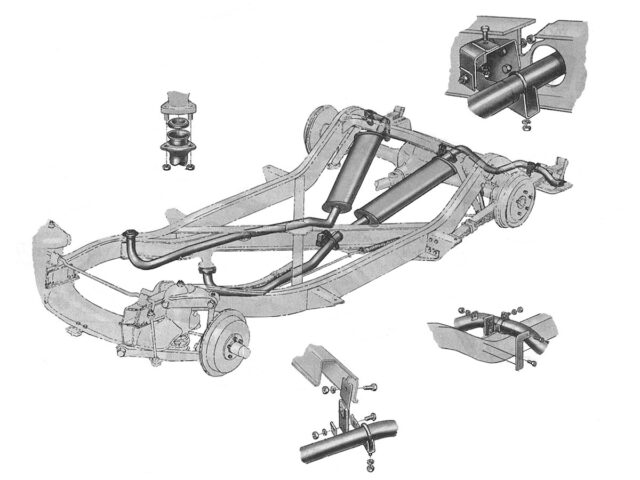
The Corvette engineers initially offered the 1953-1955 Blue Flame 6 straight six-cylinder engine, a dual exhaust featuring three cylinders per pipe. Beginning with the 1955 Corvette with the new 265 V8 powerplant, the Corvette received a true dual exhaust system, which included dual pipes and mufflers, which hung underneath the car and exited behind the rear axle. Most of the early high-performance engines used a crossover pipe, larger diameter exhaust pipes and different high performance round mufflers to increase the output of the engines. These first-generation cars used systems that required a long, large oval muffler that was located in front of the rear axle. The 1 7/8” exhaust pipes on these early systems were actually routed through parts of the frame. The 1953-1960 tail pipes were routed thru the rear body/bumpers, 1961-1962 were routed under the body behind the rear wheels. 2.5″ exhaust manifolds were introduced on the 1962 340HP and fuel-injected Corvettes. The same basic system was used through the 1962 model year.
Shop 1953-1962 Corvette Exhaust
1963 to 1967 C2 Corvette
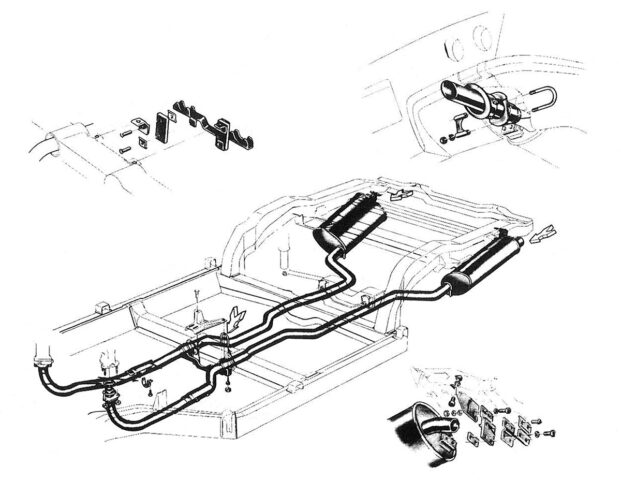
With the introduction of the 1963 Corvette, the exhaust system changed to match the new frame design. Although the exhaust pipes still were routed through the transmission cross-member, the rest of the system was hung underneath the car without passing through any other frame support. 1963-1967 pipes were either 2″ or 2.5″. 1963-1965 exhaust manifolds could be either 2″ or 2.5″ outlet size.
After 1965 all small block engines had 2″ manifolds, although the higher horsepower engines continued to have 2.5″ pipes, which had a smaller 2″ connection to the manifold. Big block engines had 2.5″ manifolds and pipes.
Also, the mufflers were relocated to behind the rear axle and were much smaller in comparison with the larger mufflers on the earlier cars. There were several mufflers also available from the factory, totally dependent on engine and transmission choices. Also new for 1963 was the off-road N11 exhaust. This system was actually a low restriction muffler with 1 less baffle designed for off road use but used the same pipes and hardware as the standard Corvette system. Regardless of the pipe size or engine horsepower, muffler outlets are always 2.”.
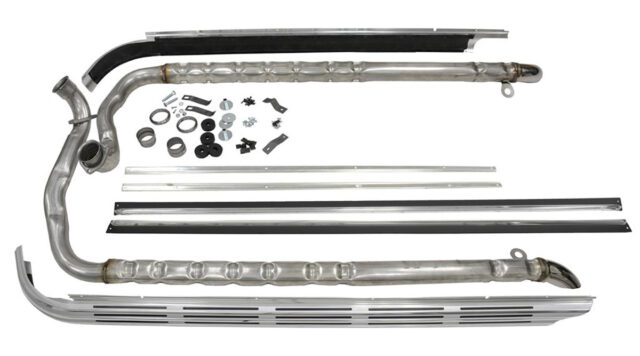
New for 1965 was the famous Corvette side exhaust. These side pipes used a chambered pipe design (manufactured by Walker) in which a perforated pipe was installed inside an aluminized 2 1/2″ crimped pipe and that comprised of the muffler system on each side of the car. There were actually two different styles of side pipes offered on the Corvette, based on the 327 small block or the new 396/427 big block engine applications offered with the car. These chambered side pipes are known to be very loud, especially after the muffler begins to age and deteriorate but interestingly enough, Chevrolet still sold them thru the parts department over 35 years after they were introduced.
Shop 1963-1967 Corvette Exhaust
1968 to 1982 C3 Corvette
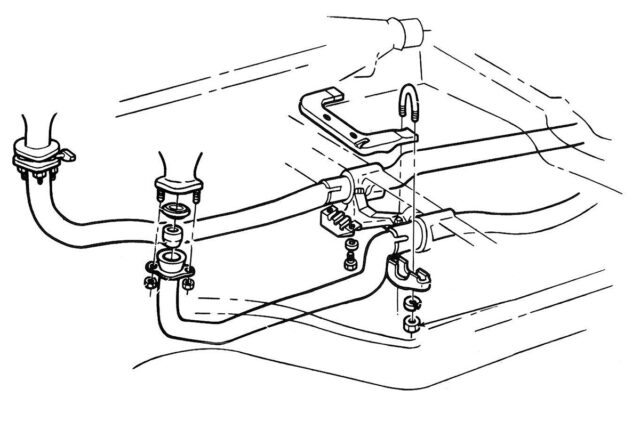
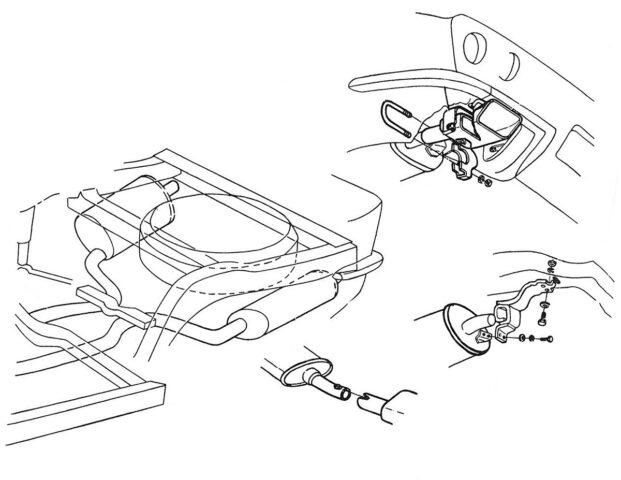
The third generation 1968 Corvette was a brand-new car for Chevrolet but used almost all of the mufflers and exhaust pipes from the 1966-67 Corvette to save GM tooling money. 1968–1982 small block engines all had 2″ manifolds, although the higher horsepower engines continued to have 2.5″ pipes, which had a smaller 2″ connection to the manifold. 1968-1974 Big blocks continued with 2.5″ pipes except for 1969, which used 2″ pipes. 1968 systems can be substituted if 2.5″ pipes are desired. The optional N11 off-road mufflers were only available in 1968, this muffler will fit 1968-1972. Regardless of the pipe size or engine horsepower, muffler outlets are always 2″.
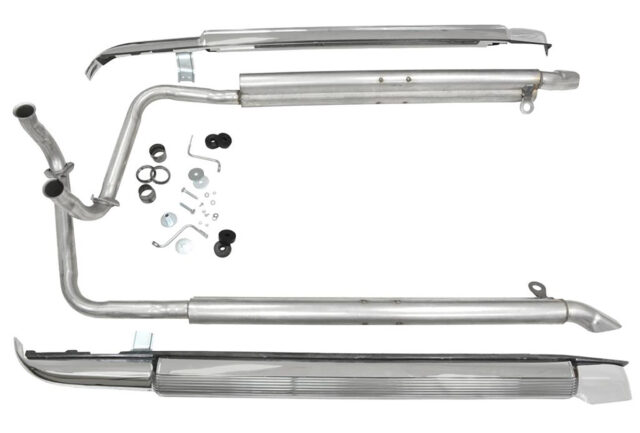
Also new for 1969 was a new set of side pipes and diecast chrome-plated aluminum covers—option code N14. These were only offered in 1969 and only 4355 cars were ordered with them, which accounted for only 11% of the total production.
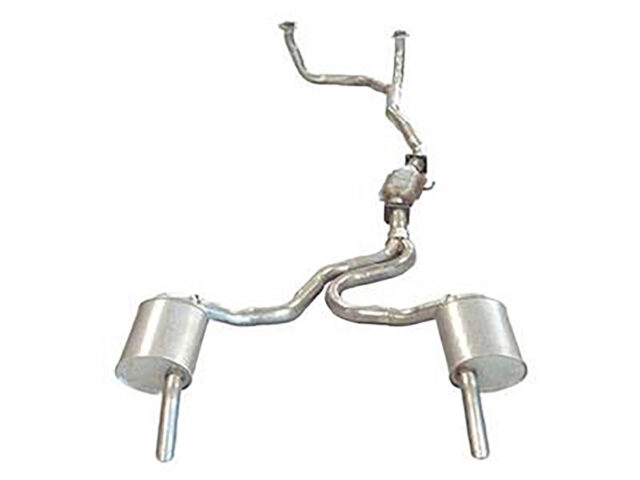
The standard Corvette system did change part numbers somewhat, but the basic design remained unchanged through 1973. The 1974 Corvette used a resonator tailpipe and was the last true dual exhaust that did not use a catalytic converter. In 1975, The Corvette dual exhaust was now gone and catalytic converters were here to stay. The exhaust now used a true “Y” pipe design which dumped into the converter and then split off again to dump into dual mufflers behind the axle and then out the tailpipes. Although there was a great deal of design changes to allow more EPA controls to be instituted into the Corvette exhaust from 1980 through 1982, this same basic system was used from 1975-1982.
Shop 1968-1982 Corvette exhaust
1984 to 1996 C4 Corvette
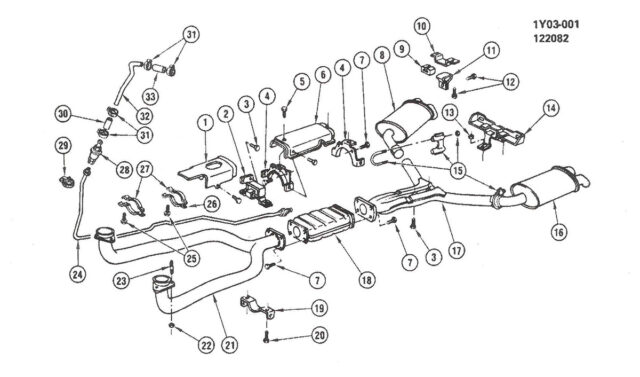
The fourth generation Corvette exhaust system was brand new to match the new car and offered a more breathable system as compared to the earlier “choked” exhaust design. This system used a “Y” head pipe, which dumped directly into the converter and then into a “Y” rear pipe design that dumped into dual mufflers. This system was much more efficient than the earlier systems and was used on both the L83 engine in 1984 and the L98 engine in 1985. Beginning in 1986, this same basic exhaust system with minor modifications was used on all L98 engines through 1991. The 1984-1991 pipe size is 2.25″.
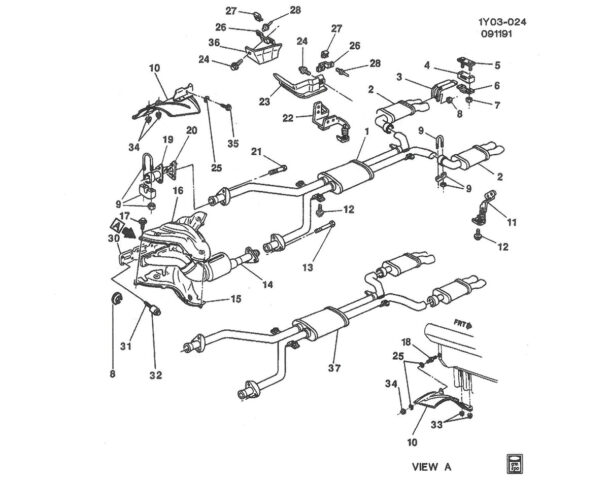
1990 through 1995, the ZR1/LT5 engine option was made available and used its own new complete exhaust system, which allowed for minor changes for options on the car. The ZR1 even used a special set of exhaust manifolds that were included and had to be ordered special for the car when replaced.
1992 the new LT1 engine was introduced. 1992-1993 systems are very similar to the other fourth generation systems but used a completely different listing in the GM parts book. The same situation exists for the 1994-95 LT 1 and the 1996 LT1/LT4 exhaust systems. Although very similar to other fourth generation Corvettes, these systems were designed to match the engine needs of the car, while still matching the chassis restraints of the car. Since these engines were all certified by the EPA singularly and on the cutting edge of producing great horsepower via a computer driven system, all exhaust systems had to be tailor-made to achieve the goals of Chevrolet. The pipe size increased to 2.75″ on LT1s and ZR1s.
Shop 1984-1996 Corvette Exhaust
1997 to 2004 C5 Corvette
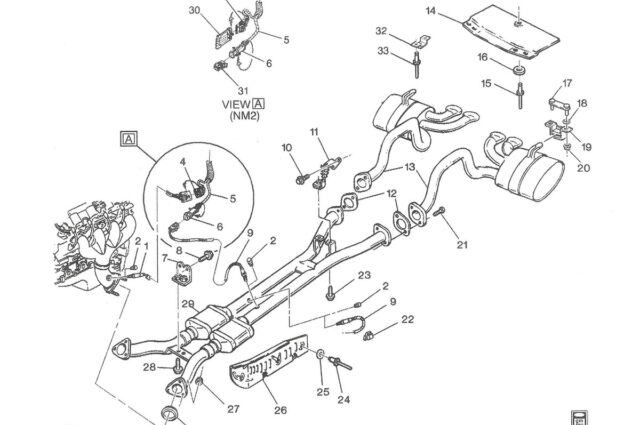
1997-2004 Corvettes have 2.5” dual pipes with dual converters. A crossover was factory installed. Mufflers are mounted laterally behind the transaxle with 4 inboard outlets. The exhaust systems used on these cars are identical through the 2004 model year, with the exception being the 2001-2004 Z06 Corvette. This system uses 3.0″ titanium pipes. The Z06 Corvette, which used the new LS6 engine, also uses a special exhaust system to maximize the breathing capabilities of the car. The actual change was the use of dual titanium mufflers (also for weight savings) that replaced the base stainless steel mufflers used on standard Corvettes. The entire muffler, including the skin and internal baffles, the outlet pipes and tips are all constructed out of titanium. 1997-2000 exhaust tips were an oval shape, the 2001-2004 including Z06 used round chrome steel tips.
Shop 1997-2004 Corvette Exhaust
2005 to 2013 C6 Corvette
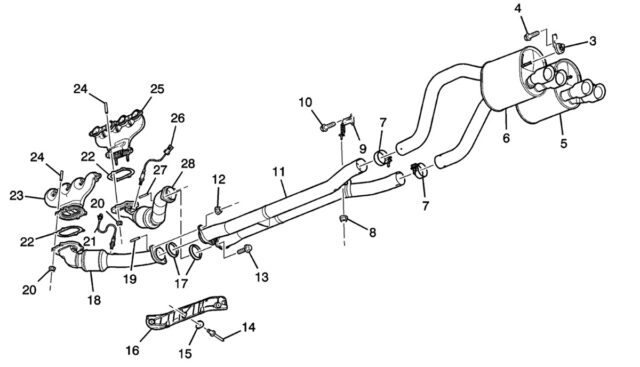
The exhaust systems of the C6 were like the C5 with a new innovation, the Dual-Mode or also known as the NPP option code, When the C6 Z06 was introduced in 2006, it became the first Corvette in history to come standard with a vacuum operated dual-mode exhaust. The NPP option became available on other Corvettes starting in 2008. This option featured a vacuum-operated valve on the muffler outlet, which opens under full throttle. The result is a more aggressive sound and added five horsepower. Pipes were aluminized stainless steel with a crossover and a converter attached to each manifold, with 3-inch polished inboard tips or 4-inch with NPP.
Shop 2005-1013 Corvette Exhaust
2014 to 2019 C7 Corvette
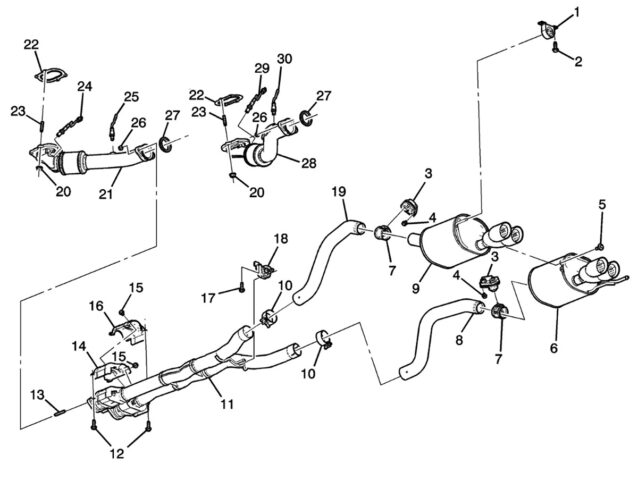
The C7 Corvette (2014-2019) exhaust ECU-controlled NPP option for exhaust continued to be offered. Sound levels were controlled based on RPM and throttle. Pipes are aluminized stainless steel, with a converter attached to each manifold, and included 3-inch inboard polished tips. The NPP features the 4-inch version.
Shop 2014-2017 Corvette Exhaust
2020 to 2024 C8 Corvette
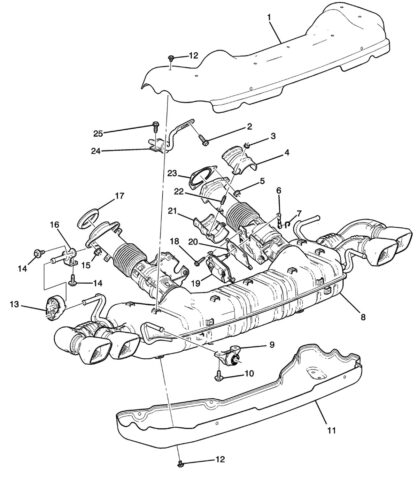
The C8 Corvette (2020-2024) exhaust is 3-inch stainless pipes meet at an X inside a large insulated housing. The new mid-engine Corvette includes AFM – Active Fuel Management. In higher gears, the PCM deactivates cylinders, and the engine operates as a V4. The muffler assembly includes a pair of AFM valves and actuators at the muffler inlets directly after the Catalytic converters. They serve to restrict the flow of exhaust in V4 mode to maintain the velocity of the flow. The base C8 Corvette has 4 outboard tips.
The 2023-2024 Z06 Corvette has 4 inboard tips with a unique design, larger diameter pipes with higher flow and low backpressure for the new flat plane crank engine. They are also nearly 20 lbs lighter than the LT2 mufflers and use a parabolic reflection design for sound.
Corvette Exhaust Systems
Corvette Central can supply Corvette exhaust systems for any model year. These applications can encompass many types of designs, which may or may not work on your particular car. Some systems from other sources are manufactured just for racing or competition applications, while some even require the cutting of original fiberglass to install them. These types of systems would never be the proper choice for a car driven on the street, as most Corvettes today would be. There are also exhaust systems available that replicate the systems of early Corvettes but use 304-grade stainless steel to maintain the correct look of the car when it was new. These systems can be more expensive and are usually installed on show cars.
Hopefully, this article has enlightened you as to some of your options for adding a better exhaust system to your Corvette. Whether you are driving every day, only on weekends, or an occasional trip down the drag strip or around the nearest road-racing course, you should be able to find an exhaust system to your liking here at Corvette Central.
Author: Alan L. Colvin
